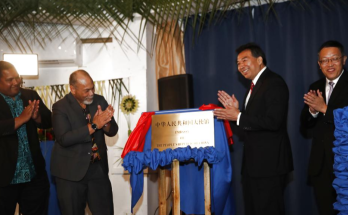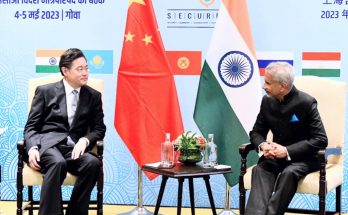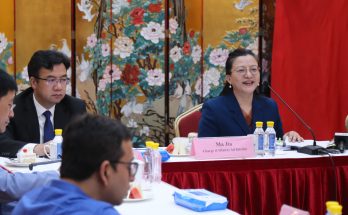 At the end of 2008, the year China stunned the world with the spectacular staging of the Beijing Olympics, the Propaganda Department of the Central Committee of CPC summoned representatives and officials of 28 parties and ministries for a meeting to discuss how to improve China’s national image. The meeting emanated from the growing realization that although for the past 30 years, China had experienced sound economic development, satisfactory political and social stability and had just concluded a remarkable Olympic Games, China’s image in the international arena did not quite match its national power. The western media has propagated a negative relentlessly –- a singularly one-sided and biased image of China, but it is now time for the Chinese media to take the initiative to promote China’s national image in a comprehensive and objective manner.
At the end of 2008, the year China stunned the world with the spectacular staging of the Beijing Olympics, the Propaganda Department of the Central Committee of CPC summoned representatives and officials of 28 parties and ministries for a meeting to discuss how to improve China’s national image. The meeting emanated from the growing realization that although for the past 30 years, China had experienced sound economic development, satisfactory political and social stability and had just concluded a remarkable Olympic Games, China’s image in the international arena did not quite match its national power. The western media has propagated a negative relentlessly –- a singularly one-sided and biased image of China, but it is now time for the Chinese media to take the initiative to promote China’s national image in a comprehensive and objective manner.
China’s international communication capability
In the meeting, it was decided that the Propaganda Department will preside over “The Project for enhancing China’s international communication capability” along with the 28 ministries and commissions and promote China’s image through various mechanisms and approaches, including media expansion, cultural communication, technical support, financial backing, manpower education and so on. The decision was followed up by ploughing an investment of RMB 48 billion (about USD 7 billion at that time) into the project. As the world’s richest government with USD 4 trillion foreign exchange reserves, China is continuously increasing the budget for this image-building project.
 How do I know so much about it? Being the director of the International Communication Research Programme of Beijing Foreign Studies University, (BFSU), I was avidly engaged in the project’s manpower education work which involved training new journalists and editors. I was summoned several times to the Propaganda Department, CPC and the Ministry of Education to attend related meetings and hence was able to observe the scenario closely.
How do I know so much about it? Being the director of the International Communication Research Programme of Beijing Foreign Studies University, (BFSU), I was avidly engaged in the project’s manpower education work which involved training new journalists and editors. I was summoned several times to the Propaganda Department, CPC and the Ministry of Education to attend related meetings and hence was able to observe the scenario closely.
Since the project has already been mentioned in several news and research reports, the information I provide in this article is anything but ‘secret’. It also underscores the efforts undertaken by the Chinese media in the last few years to expand their apparatus and influence.
In May 2014, a renowned journalist, Ms. Gao Yu, was arrested in Beijing on the charge of leaking national secret to a website outside the Great Fire Wall of China. The so-called ‘secret’ was actually an ideological document released by the Chinese Communist Party, prohibiting public discussion about constitutionalism, press freedom, civil society etc. The full text of the document was, however, already viral on the internet before she “leaked” it.
Media expansion for promoting China’s Image
T he foremost priority of the communication project is to implement the “media going out” strategy to improve China’s image by positive and favourable reporting. Despite a festering slump in the global newspaper industry, China’s official media is thriving and booming with abundant funding. The Party’s flagship newspaper, People’s Daily, has a small domestic readership due to its excessive ideological propaganda but it has been recruiting top-notch staff and establishing branch bureaus worldwide by utilising preferential government policies. In 2012 alone, five of my graduate students were recruited by People’s Daily and were all sent out to the United States, Europe and Asian-African-Latin American countries in the same year. Meanwhile, the newspaper has also set up a giant website for itself, got itself listed on the stock market and has also wasted RMB 2 billion (USD 300 million) of the tax-payer’s money to develop an unfruitful search engine. All these could not have been done without enough funding.
he foremost priority of the communication project is to implement the “media going out” strategy to improve China’s image by positive and favourable reporting. Despite a festering slump in the global newspaper industry, China’s official media is thriving and booming with abundant funding. The Party’s flagship newspaper, People’s Daily, has a small domestic readership due to its excessive ideological propaganda but it has been recruiting top-notch staff and establishing branch bureaus worldwide by utilising preferential government policies. In 2012 alone, five of my graduate students were recruited by People’s Daily and were all sent out to the United States, Europe and Asian-African-Latin American countries in the same year. Meanwhile, the newspaper has also set up a giant website for itself, got itself listed on the stock market and has also wasted RMB 2 billion (USD 300 million) of the tax-payer’s money to develop an unfruitful search engine. All these could not have been done without enough funding.
China Daily, an old, official English newspaper based in China, even established a US edition with headquarter in the most expensive office building on Times Square and eight printing locations throughout the US. Meanwhile, American readers virtually do not have to pay for this finely-produced newspaper.
The CCTV (China Central Television) also boasts of several multi-lingual satellite channels. In order to win more subscribers, it provides free service or even subsidises services for foreign users, especially those in the African market. Its correspondents are stationed worldwide. It also hires many local anchors, and runs several regional stations.
Xinhua, China’s largest news agency, is establishing its own Xinhua Television Network, besides providing news, photos and website services. Another official Chinese news agency, China News Service, is also planning a similar expansion. CRI (China Radio International), which provided multi-lingual broadcast to foreign countries for political purposes via short waves only, has now changed its name to CIBN (China International Broadcast Network) and has been producing its own TV programmes. Besides, it has also purchased around a hundred radio stations worldwide to make local broadcast via FM and MW.
Apart from sponsoring the above mentioned six media ventures, the Chinese government has also tied up with several important universities, such as Renmin University of China, and has been offering MA in international journalism and communication along with enviable scholarships, internships and job opportunities. These MA programmes focus on foreign language fluency and ideological loyalty. Many of the graduates will be recruited as journalists in the official media for foreign propaganda.
Cross-cultural communication Currently, Confucius Institutes or Confucius classrooms have been established throughout the world. They provide free fortnightly classes. While China provides all the funding, teachers, and teaching materials, for the foreign institutions as a collaborator all they need to do is to provide training space and students for the classes.
China often launches initiatives like “cultural year” in foreign countries which feature shows and exhibitions and offer visiting invitations. It also regularly hosts events such as the Boao Forum for Asia, and the Davos Summer Forum (in Tianjin, China) to showcase its economic and political well-being, and to demonstrate the influence of the ‘China Model’ or the ‘Beijing Consensus.’ The Chinese government has invested a vast amount of financial and human resources to translate one-sided political, economic and cultural books into many foreign languages to highlight the theories and practices of Socialism infused with Chinese characteristics, its harmonious society and peaceful rise in the rest of the world.
Since Hu Jintao’s presidency, the Chinese government has made innumerable China Image videos, documentaries and soft advertisements for publicity. It purchased the big bulletin board on Times Square, New York, slots and page layouts of foreign media to either play these videos repeatedly or publish such advertisements, in order to warm up the atmosphere during the Chinese leader’s foreign visit. This ad blitz showcases the achievements of “Made in China” products and China’s contribution to the world.
With the support of the central government and the Chinese people, Beijing and Shanghai proudly and successfully hosted the Olympic Games and the World Expo. Since then, nearly all cities in China have been eager to host events and expositions to demonstrate their athletic, economic, and cultural feats. China’s public diplomacy has never been more vibrant.
The Other side: China’s media expansion and public diplomacy
 Despite the Chinese government investing enormous financial and human resource to promote its national image and public diplomacy, the outcome has not been as expected and sometimes it has even been counter-productive. For example, the figures that appeared in the China Image videos are far from being representative of the Chinese people, with their focus on showcasing the glitzier and, wealthy side of China. Polls have also shown that ordinary Americans felt even less friendlier towards China after seeing the video at Times Square, assuming that the Chinese people are trying to occupy the American market and threatening to grab their jobs. The visuals of army marching and spacecraft launching have especially rekindled the notion of the “China threat”.
Despite the Chinese government investing enormous financial and human resource to promote its national image and public diplomacy, the outcome has not been as expected and sometimes it has even been counter-productive. For example, the figures that appeared in the China Image videos are far from being representative of the Chinese people, with their focus on showcasing the glitzier and, wealthy side of China. Polls have also shown that ordinary Americans felt even less friendlier towards China after seeing the video at Times Square, assuming that the Chinese people are trying to occupy the American market and threatening to grab their jobs. The visuals of army marching and spacecraft launching have especially rekindled the notion of the “China threat”.
The primary problem is that the Chinese government does all the work by excessively aggrandising political image, with little participation from scholars, professionals and civil groups. However, in reality, China has long been immersed in corruption, scandals, poverty, environmental pollution, and food safety issues. When it comes to reporting on China, the “all is good news” stance of the Chinese media and public diplomacy is in stark contrast to the western news value of “bad news is good news.” The proliferation of media outlets and the non-tuition Confucius institute is intriguing as it does not take rocket science to figure out where the money is coming from. People not only doubt these ventures’ sustainability, but also worry about the effects of such propaganda and possible corruption amid serious education, health, pension and housing problems in China.
The biggest issue is, if a government has tarnished its own image domestically due to dictatorship, corruption, low social welfare, violation of human rights and the rising discontent amongst its own people, how can it persuade the international society to accept a positive image of it? In 2012, Abebe Gellaw, an African journalist, being interviewed by The New York Times during the establishment of CCTV’s African headquarter in Nairobi, Kenya, said, “The Chinese are not interested in bringing freedom of information and expression to Africa, if they don’t provide these freedoms to their own citizens, why should they behave differently elsewhere?” (NYT,“Pursuing Soft Power, China Puts Stamp on Africa’s News”, August 16, 2012)
Therefore, the China Image will be popular internationally only if its government’s domestic image improves amongst its own people by providing welfare, freedom and human rights for all.
(Dr. Qiao Mu is an associate professor of communication at Beijing Foreign Studies University.)
Author Profile
- India Writes Network (www.indiawrites.org) is an emerging think tank and a media-publishing company focused on international affairs & the India Story. Centre for Global India Insights is the research arm of India Writes Network. To subscribe to India and the World, write to editor@indiawrites.org. A venture of TGII Media Private Limited, a leading media, publishing and consultancy company, IWN has carved a niche for balanced and exhaustive reporting and analysis of international affairs. Eminent personalities, politicians, diplomats, authors, strategy gurus and news-makers have contributed to India Writes Network, as also “India and the World,” a magazine focused on global affairs.
Latest entries
 DiplomacyApril 23, 2024Resetting West Asia, re-booting the world, but not fast enough: T.S. Tirumurti
DiplomacyApril 23, 2024Resetting West Asia, re-booting the world, but not fast enough: T.S. Tirumurti India and the WorldApril 22, 2024India’s G20 Legacy: Mainstreaming Africa, Global South in global agenda
India and the WorldApril 22, 2024India’s G20 Legacy: Mainstreaming Africa, Global South in global agenda DiplomacyApril 10, 2024Diplomat-author Lakshmi Puri pitches for women power at LSR
DiplomacyApril 10, 2024Diplomat-author Lakshmi Puri pitches for women power at LSR India and the WorldApril 6, 2024UN envoy pitches to take India’s solutions to the world stage
India and the WorldApril 6, 2024UN envoy pitches to take India’s solutions to the world stage







